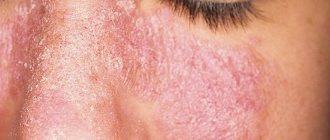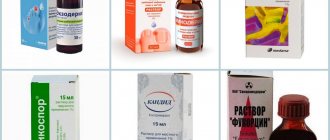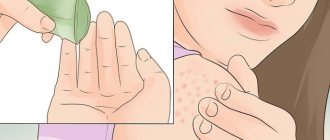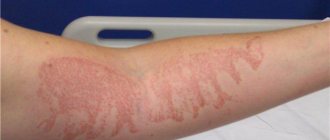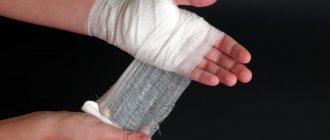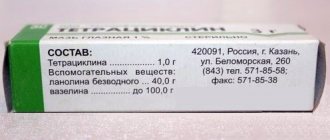Currently, a drug such as heparin ointment (pictured) is widely used. The presence of this ointment in almost every first aid kit is due to its good effectiveness, ease of use and relatively low price. But along with all the known properties of the drug, it has an antithrombotic effect on hematomas, improves microcirculation in blood vessels, it has a number of other positive indicators.
First of all, it should be noted that this drug can be used for burns. However, the instructions do not directly state its healing anti-burn properties. But at the same time, blood clots and hematomas are symptoms of many pathological phenomena in the body. Therefore, the question of how heparin ointment helps with burns, and whether it should be considered an anti-burn agent, should be sorted out.
Composition and pharmacological properties of the product.
What are burns and what are they?
Skin damage due to burns is considered one of the most dangerous and severe traumatic conditions. Injuries of this type occur in both adults and children, and in such situations a serious and correct approach to treatment is required. The most effective and popular means of therapy are ointments for skin burns. They significantly speed up recovery and are of great benefit in preventing complications.
Depending on what external factor caused the injury, the following types of burns are distinguished:
- thermal. They are formed upon contact with hot steam or air, hot objects, boiling water, as well as when viscous hot substances (caramel mass, resin, etc.) come into contact with the skin. For this type of damage, an ointment or a special cream for thermal burns will help;
- electric. Such damage mostly occurs among those who work with electrical equipment, as well as from lightning strikes. For such injuries, it is not enough to use only ointment against burns, because in addition to damage to the skin, the functioning of the respiratory organs, heart and other body systems is also disrupted;
- chemical. They arise due to contact with different types of chemicals and depending on the duration of exposure to the substance, the depth of the wound and the degree of complexity directly depend. For injuries of this type, ointment for chemical burns is considered an effective painkiller and therapeutic drug;
- radial. This group includes skin damage caused by ultraviolet rays. Most often, such injuries occur in a solarium or on the beach due to prolonged exposure to the sun.
Regardless of the cause, any burn causes severe pain. Therefore, one of the important stages is the quick and correct provision of first aid to the victim. Medicinal ointments for burns should be noted as first aid medications.
In addition to the types of skin injuries, depending on the causes, there are also different degrees of complexity of burns, the descriptions and signs of which are presented in the table.
| Burn degree | Difficulty of damage | Characteristic symptoms | Recovery period |
| 1st degree | Mild, superficial damage to the epidermis Sometimes there may be slight swelling | Slight redness of the injured area | Since the skin damage is minor, complete recovery occurs within a week. To restore the skin in such cases, ointments for 1st degree burns help. |
| 2nd degree | Moderate damage | Skin becomes blistered and prone to cracking | In the process of bursting blisters, the wound may become infected, so the most effective here will be a burn-healing ointment containing an antiseptic or antibiotic. The healing period can last up to a month |
| 3rd degree | Severe and dangerous injury | The skin is completely destroyed A scab with a brown or black tint appears at the site of injury | Ointment for burns will be of little help here; such injuries cannot be avoided without hospitalization and complex drug treatment. The recovery period depends on the individual characteristics of the body and the area of damage |
| 4th degree | Injuries of the highest severity | The superficial layer of skin is missing Bones are damaged Tendons and muscle tissue die | Treatment is carried out exclusively in inpatient hospital settings. Anti-shock therapy, intravenous injections and medications are used |
If for minor injuries any ointment for 1st degree burns will provide effective treatment, then for more serious injuries you should seek medical help and only then use any medications.
Anti-burn ointments, creams: features of the dosage form
A huge variety of products that promote rapid restoration of the skin after burns exists today. But how to choose the most suitable drug and what is the best ointment for burns?
Not all local remedies have the same effect on burn injuries. Which one is suitable in a particular case can only be determined with accuracy by a specialist. But for minor injuries, you can choose the drug yourself.
A variety of local remedies are widely used in the treatment of burn wounds. Ask what is better to use - ointment or cream for thermal burns? Creams, ointments, gels are a soft dosage form that is applied directly to the lesion.
Typically, such products consist of a base and auxiliary medicinal components evenly distributed in it. In addition, preservatives, surfactants, stabilizers and other substances can be used in the composition. Depending on the composition, the products have a certain effect, but in general the principle of their influence on a burned wound is almost the same and ensures the concentration of the active substance at the site of damage.
How is therapy tolerated?
Most patients do not experience any side effects during treatment, but the possibility of their occurrence cannot be ruled out. As an individual reaction to the components of the drug, the patient may experience skin itching, an allergic rash, and irritation at the site of use. In rare cases, urticaria and eczema may appear.
Important! Any adverse reactions during treatment with heparin drugs are a reason to stop using and contact the specialist who prescribed the medicine.
What remedies will help relieve skin burns?
Violation of the integrity of the skin due to burns can lead to negative consequences. Any wound, even the smallest one, opens the way for infection to enter the body. Therefore, it is very important to provide immediate assistance in the first minutes after a burn injury.
When the degree of complexity of the burn is high, it is impossible to limit yourself to home treatment and it is necessary to urgently call an ambulance. For mild to moderate damage, ointment for 2nd degree or 1st degree burns can be used for treatment.
To relieve symptoms, the pharmacological market offers various local remedies for burns: ointment, gel, spray, cream, special patches and others. All of them are conditionally divided into certain groups:
- products based on steroid hormones. Quickly and effectively relieve pain and inflammation. Which ointment for burns containing hormones is the most effective. Such products include Afloderm (a cream useful for sunburn), Fluorocort ointment, Elokom lotion and cream, and many others. With short-term local use, such drugs do not pose any danger to the body;
- antihistamine non-hormonal compounds. Significantly reduce itching, prevent inflammation of the epidermis, reduce burning in the affected area and relieve swelling. The most common drugs are Ketocin ointment, Fenistil gel, Balimin gel;
- anesthetic drugs. Relieve pain syndromes and quickly alleviate the condition of the victim. For example, for sunburn, Luan gel or Amprovisol spray quickly relieves pain;
- antiseptics. Recommended for use when bubbles form. In most cases, their appearance causes a burn with boiling water; treatment with an ointment with an antiseptic effect will prevent infection of the skin tissue, accelerate the regenerative process and prevent inflammation. This group includes formulations with silver sulfadiazine, miramistine or chlorhexidine: Dexpanthenol, Argosulfan, Silvederm cream, Bepanten, Miramistin ointment and others;
- healing local remedies. They should not be applied immediately after a burn injury. Their action is useful after the acute period of damage has passed. The most common drugs with a healing effect are spray or ointment Olazol, Solcoseryl ointment, Lifuzol.
What is better to use and what can be used for burns: ointment, cream, lotion or other formulations? It should be understood that even mild burns are accompanied by pain and burning. Therefore, in such cases, it is better to use creams and ointments with a thinner consistency, gels and sprays that can be easily applied without causing additional pain to the victim.
In addition to ointments, gels and creams, for burns, you can use special dressings soaked in anti-inflammatory, antiseptic and other substances to promote rapid restoration of the epidermis. Burn patches, which, unlike bandages, do not require additional fixation, have a similar effect. But they are relevant only for small-sized burns.
Drugs in the regeneration phase
In the case of a normal recovery process, granulation of the wound begins after seven days. The damaged area is filled with new maturing connective tissue, blood vessels and epithelial cells. During this period, the use of ointments with a high fat content is not recommended. For tissue healing at this stage, creams containing silver are needed. There are strict restrictions on the use of these drugs. Therapy should not be carried out longer than two weeks.
To avoid drying out and cracking of the epithelium, and also as antibacterial prophylaxis, the following are used:
"Dermazin" - Apply to the burn wound in the morning and evening. Removes necrotic manifestations. Active against all types of pathogens found in lesions of this type.
The following side effects have been noticed:
- the skin acquires a brownish tint;
- irritation;
- itching
"Agrosulfan" - Has bacteriostatic properties. Removes pain and burning. Able to prepare a wound for tissue transplantation. In some cases, it improves the condition of the affected skin to satisfactory. Eliminates the need for surgery.
Contraindications:
- infants, less than two months;
- patients with liver dysfunction;
- during pregnancy.
- In rare cases, a rash on the skin may occur.
"Ebermin" - Can be used at any stage of the process. It has proven itself to be an effective remedy. Ensures rapid healing. Has a detrimental effect on fungi, harmful microorganisms, and dermatophytes. Eliminates the dehydrating effect, relieves pain.
Contraindicated:
- during pregnancy;
- infants under one year old.
Before use, it is recommended to treat the surface with an antiseptic.
In cases complicated by suppuration, drugs that include an antibiotic are used:
- "Streptocinol";
- "Methyluracil";
- "Miramistin";
- "Nitacid";
- "Procelan."
At the stage of restoration of the epidermis, you need to use products that moisturize the surface and prevent the formation of scars.
Light burns: what ointments help?
Modern pharmacology offers a variety of ointments and remedies for burns that help restore the integrity of the skin. They contain antimicrobial and antibacterial components that prevent infection and the development of inflammatory processes.
The following ointments for 1st degree burns are considered the most common in therapeutic practice:
- Levomekol. The main active ingredients are chloramphenicol and methyluracil, which effectively destroy harmful microorganisms. The ointment is recommended for use in the presence of suppuration or wounds from burst blisters. For example, Levomekol for burns with boiling water or some hot object promotes rapid restoration of the skin, while preventing infection;
- Panthenol is a pretty good ointment for healing burns. The drug is also available as a spray, cream and emulsion. Significantly relieves sunburn;
- combined local remedy - Heparin ointment for burns, helps with injuries of 1st and 2nd degrees. But ointment is not suitable as the main drug for burns. It is advisable to use it as an adjunct to prevent the formation of thrombosis, reduce the inflammatory process and relieve pain;
- Furacilin ointment for mild burns quickly and effectively relieves inflammation and has a bactericidal effect on the wound. Has a pronounced antiseptic effect. Quite popular for eliminating the consequences of burns in pediatric therapy;
- Argosulfan is a highly effective healing ointment for burns, consisting of the antimicrobial component sulfathiazole and silver ions. Indicated for extensive burns of various degrees, as well as to prevent scars. It has analgesic, wound healing and antibacterial effects. The ointment can provoke an allergic reaction, so it is not suitable for everyone;
- Actovegin is a good ointment for burns with boiling water when blisters have formed on the injured area. It is made on the basis of a substance from the blood of dairy calves, deproteinized hemoderivative. Accelerates the healing process of wounds caused by thermal burns. Can be used by women during pregnancy and breastfeeding.
These are only the most popular ointments for skin burns; the list is actually much more extensive. Unlike treatment with tablets or injections, the ointment acts on the wound immediately after its application, while other agents must first dissolve in the blood.
Contraindications for use
To prevent negative events during treatment, it is necessary to have an understanding of the contraindications associated with the use of heparin-based medications. The instructions include this list, however, in the case of treating burn wounds, permission from a doctor is required.
Important! Heparin-based medications can be used in the treatment of 1st or 2nd degree burns resulting from thermal or ultraviolet exposure.
Use is prohibited if the following indicators are present:
- individual intolerance to the substances included in the drug;
- hemophilia;
- increased vascular permeability;
- tendency to bleed;
- low platelet count in the blood;
- vein thrombosis
Like all drugs in anti-burn therapy, heparin ointment has its disadvantages and advantages:
| Advantages | Flaws |
|
|
What ointments to use for bacterial lesions
Even with minor skin damage due to burns, the recovery period can be significantly delayed if an infection enters the wound. In such situations, it is necessary to use antibacterial creams, gels and ointments for burns.
The main products with antimicrobial and antibacterial effects include the following:
- Streptocidal ointment is an excellent remedy for fighting local infections and has a powerful antibacterial effect. Attention should be paid to the fact that the ointment has a number of side effects and contraindications, so before choosing it for treatment, you should consult a doctor;
- Tetracycline ointment is a very effective and inexpensive remedy for burns. Does not cause side effects. Belongs to the group of antibiotics, eliminates inflammation, prevents tissue infection in open wounds;
- Baneocin ointment is considered effective for burn injuries due to the presence of two powerful components - bacitracin and neomycin. The ointment is easily tolerated, the list of contraindications is minimal;
- Calendula ointment for burns is very useful, especially in the presence of infected wounds. When applied to damaged areas, the ointment has a reparative, antimicrobial and anti-inflammatory effect, reduces the severity of edema, prevents epithelization, and promotes tissue contraction at the edges of the wound;
- Dermazin ointment has proven itself well in the treatment of infected burn surfaces. Also available in cream and aerosol form. Effectively destroys pathogenic microflora. It can be used both for burns in adults and in children from one month old.
There are also many other combined and regenerating ointments, with the help of which burns, even when wounds become infected, can be quickly and effectively healed and the integrity of the skin restored.
Side effects
Dermatitis is an allergic reaction of the body in response to the use of the composition.
Heparin-based drugs in most cases do not provoke any complications, so they are considered to be well tolerated by the body. However, a number of unpleasant situations may arise for the patient due to side effects. First of all, this is an allergic reaction to one of the components of the medicine.
Remedies for chemical burns
Violation of the integrity of the skin can be caused by various factors, the most aggressive of which are chemical burns. And anyone can suffer from such injuries, even with careful adherence to safety rules. What to do in such situations, how to alleviate the condition and what means to use as first aid?
Special ointments for burns caused by contact with chemicals will help reduce pain and prevent inflammation.
The table provides information on the most popular remedies used for chemical burns
| Drug name | Purpose | Mode of application | Result |
| Solcoseryl ointment | For the treatment of skin in the phase of its epithelization, when the wound is no longer oozing | Pre-treat the damaged area with a disinfectant solution, then apply the mixture to the wound and apply a bandage over it | For mild cases, the skin recovers in about a week; for deep wounds, it will take 14-20 days. |
| Bepanten ointment | Has a wound-healing effect, moisturizes the skin, prevents the formation of scars and scars. To be applied to the mucous membranes of the body for their rapid healing | Apply ointment to the injured surface. For mild damage, one use per day is sufficient. Should be used until the epidermis is completely restored | Accelerates the epithelization of skin tissue, provides an analgesic effect. With daily use, the burn marks completely disappear within about a week. |
| Eplan ointment | Resists wound infection, promotes rapid healing, and relieves inflammation. This is an excellent ointment for burns on the face, since it does not contain antibiotics, analgesics or hormones. | Apply a thin layer of the product to the burned area and cover with a sterile bandage. | After 5-7 days of using the ointment, skin restoration becomes noticeable |
| Sudocrem | An effective cream for chemical burns on the face. Forms a protective film, thus protecting the wound from infection | Apply to damaged areas, avoiding contact with eyes. | Depending on the severity of the burn, it provides recovery in approximately 7-10 days |
| Algofin cream | An ideal cream for burns on the face with deep wounds. Accelerates cell regeneration, restores the epidermis and protects against inflammation | Can be used by everyone due to the absence of contraindications | Eliminates oxygen starvation in the damaged area, promotes rapid healing of damaged tissues |
| Turmanidze ointment | Stimulates tissue regeneration, has a moderate antiseptic and analgesic effect, ensures cleansing of the burn wound from necrotic masses | Indicated for use with 1st, 2nd and 3rd degree burns | Effectively and quickly heals burn wounds of varying severity |
This list can be continued indefinitely, but when choosing a particular cream or ointment, you should understand that a chemical burn can cause complications for the entire body. Therefore, for high-quality and correct treatment, it is necessary to immediately consult a doctor after a skin burn with chemicals, who can assess the complexity of the condition and prescribe the most effective medications.
Treatment with ointments at home
In addition to drugs from the pharmacy, burns from chemicals or other thermal factors can be treated with ointments that are prepared at home.
- Universal anti-burn ointment
To prepare a universal remedy, you need to prepare sea buckthorn and St. John's wort oil, as well as one egg yolk. To prepare the product, simply mix these components and apply to the burn-affected areas of the body.
After application, a sterile, loose bandage is applied to the top, which should be changed every other day. According to people, using this remedy, improvements occur within 3-4 days.
- Starch ointment
To make the ointment, you need to beat a small piece of butter, penicillin, anesthetic and potato starch with a mixer or with your hands. The resulting homogeneous mass is applied in a thick layer to the affected area of the body for about 30 minutes. When the ointment is absorbed, it is replaced with fresh one. Using this remedy, you can quickly numb the burn area and prevent the formation of rough scar tissue.
- Walnut ointment
To make nut ointment you need to prepare walnuts and egg white. Nuts should be mashed to a paste and protein should be added to them. This ointment is applied to burned areas of the skin 3 times a day. This simple remedy is used for quick healing after chemical and any other types of burns.
Eye burns: first aid
Depending on the type of damaging factor, eye burns can be thermal, radiation and chemical, and they are all divided according to the location and depth of damage. At the site of injury, burns of the choroid, eyelids, retina, cornea, lens and conjunctiva are distinguished.
What to do if the eye is damaged, what ointment for burns is effective and approved for use? Treatment of burn injuries to the eyes should be carried out exclusively by an ophthalmologist. If it is impossible to urgently transport the victim to the hospital, then as first aid for the purpose of pain relief, you can carefully apply a special cream, gel and ointment for burns around the eye, for example, the eye drug Floxal or Tetracycline.
It is impossible to determine the severity of eye damage on your own, so the patient must receive professional medical care as soon as possible.
Burns in children: what remedies can be used?
No matter how carefully and responsibly parents look after their children, the number of child injuries and in particular burns is quite high. This is especially true for children aged 1-5 years, and burns occur mainly thermal.
Moms and dads need to prepare for such situations in advance in order to provide timely assistance to the child in case of burn damage to the skin.
For burn injuries in children, the following remedies will be useful:
- Rescuer is an excellent balm for burns, consisting of components of natural origin: bee propolis, gum turpentine, sea buckthorn oil, vitamin E, milk lipids, essential oils of rosemary, tea tree, lavender. Stimulates cell restoration, disinfects and anesthetizes the wound, stops bleeding, eliminates dryness, prevents scarring, softens and nourishes the skin. Already 5-10 minutes after applying the composition, the pain subsides and after 3-6 days the wound heals completely;
- Sulfargin is an ointment for burns that heals injuries of 1-3 degrees of complexity. The drug does not contain any alcohol compounds, hormones, preservatives or dyes, which allows it to be used even for small children from 3 months of age;
- Olazol spray. An excellent remedy that has a double effect: an anabolic steroid provides pain relief, sea buckthorn oil promotes rapid tissue regeneration and wound healing. The composition is recommended for signs of infection, for burn injuries of medium depth and for weeping burns;
- children's ointment after burns Radevit. The composition is enriched with a complex of vitamins A, E and D, is easily rubbed in and quickly absorbed. Can be used for babies over one year old. Accelerates healing, prevents the formation of scars or scars on the skin;
- Boro Plus is another effective ointment for burns from boiling water for children. Made from herbal ingredients, it has a pleasant smell. Application of the composition is advisable at the final stage of treatment in order to prevent scars and scars. Can even be used for infants;
- La-Cri is an excellent cream for children, based on Panthenol. Contains violet extract and bisabolol as auxiliary components. It can be used as a remedy for burns and during the rehabilitation period after an injury. Approved for use by very young children;
- Contractubex gel perfectly smoothes scars, creating uniformity and evenness of the skin. The gel can be used by children from birth as a restorative and healing agent for burns on open areas of the body.
Other ointments, creams, and sprays for the treatment of burn injuries will also be useful in your home medicine cabinet: Bepanten, Lioxazine, Allantoin, Methyluracil and others. All existing ointments for children - pain relievers for burns or resolving scars - act at the cellular level, accelerate regenerative processes and restore the protective layer of the epidermis.
What are the possible contraindications?
Heparin ointment is contraindicated in pregnant women and nursing mothers, since sodium heparin can have an embryotoxic effect on the fetus and pass into breast milk. The product should not be used for diseases of the hematopoietic system or bleeding disorders. For long-term non-healing wounds and ulcers, as well as surrounding tissues, the use of heparin ointment is also contraindicated.
Note! Heparin is a substance with increased allergenic properties, so people with a tendency to allergies can use drugs based on it only under medical supervision. The drug is prescribed with caution for bronchial asthma and other pathologies of the respiratory system.
Heparin ointment is an affordable and fairly effective treatment for skin diseases accompanied by an increased risk of thrombosis and inflammatory reactions. The main indication for the use of the drug is inflammation of hemorrhoids of varying degrees. In anti-burn therapy, the medicine is used as an auxiliary component to more quickly relieve the inflammatory process, relieve pain on the wound surface and restore blood flow in the blood vessels of the damaged area.
Using ointments for burn injuries: advantages and disadvantages
Regardless of the nature of the burn, it is very important to provide timely assistance to the victim in order to prevent infection and speed up the process of skin restoration. For this purpose, it is advisable to use wound-healing creams, gels, sprays and ointments for burns, which are presented in a wide variety by modern pharmacology.
The advantages of using ointments, creams and other special external products are as follows:
- versatility. Any remedy, be it a spray, gel or ointment for burns, regardless of the size and complexity of the damage, can be applied directly to the injured area;
- convenience and ease of use. In order to treat the burned surface of the skin, you do not need any special skills. Anyone can provide first aid to a victim using ointment or gel for burns;
- efficiency. Almost all products have anti-inflammatory, soothing and antiseptic effects, which provides an instant effect when applied to the damaged area and quickly reduces pain;
- Using ointments to treat thermal burns, all necessary procedures can be performed at home and independently;
- wide choose. Pharmacies offer a variety of drugs: regenerating, painkillers, promoting the resorption of scars, anti-inflammatory. The range includes ointments, gels, sprays and creams for burns of thermal, radiation or chemical origin.
At the same time as the restoration of the epidermis, local products also moisturize the skin tissue well, which is very important for thermal burns.
Along with the high effectiveness of ointments, there are also some disadvantages:
- some types of formulations contain fats;
- the impossibility of using a thick consistency ointment for wounds and burns for severe injuries, since application to the injured area causes pain;
- Before applying ointment or cream to the damaged area, it must first be degreased with special means to achieve maximum effect.
In comparison with the effectiveness and positive aspects of treating burns with ointments, the disadvantages of their use are insignificant, but they still need to be taken into account when choosing a specific product. At the same time, an undeniable advantage is that sprays, gels, and ointments for burns are applied directly to the problem area, providing an instant effect due to the concentration of medicinal substances in it.
Composition of the drug
The therapeutic effect of using heparin ointment is ensured by its constituent components. The formula of the drug is based on three active ingredients:
- heparin is a direct-acting anticoagulant, which under normal conditions is synthesized by the body of living beings (10,000 units per 100 g);
- benzyl nicotinate - a means to expand the lumen of blood vessels and arteries, as well as local anesthesia of damaged tissues (0.08 g per 100 g);
- anesthesin is a substance with a local anesthetic effect used for surface anesthesia.
Benzyl nicotinate in the ointment improves the absorption of heparin and provides a more pronounced therapeutic effect. Peach oil, used as an auxiliary ingredient, helps soothe damaged skin and speed up the process of tissue regeneration.
The product is available in aluminum tubes or dark medical glass jars of 25 g.
First aid for burns: procedure
Proteins are an important component of skin cells. They form the structural framework of skin tissue and provide physical protection to the epidermis. When exposed to high temperatures, proteins lose their original shape and are destroyed, which causes damage to cells and tissues, and this happens even with mild burns.
How to prevent complications? What ointment is effective for burns and how to apply it correctly? The severity of the burn must first be determined. If the injury is particularly severe, the victim must be taken to a hospital or clinic as soon as possible. You can deal with milder injuries yourself by using ointment for 1st degree or 2nd degree burns.
The procedure for burns of 1-2 severity is as follows:
- The injured areas must first be carefully cooled. You can use cool water for this, but you should place the burn area under a strong stream, as this will further intensify the pain. It is better to take a gauze bandage moistened with water and apply it to the sore spot for about 10-15 minutes;
- if your fingers are damaged, then you need to immediately remove all the rings before swelling occurs;
- When blisters appear, you should never pierce them, but only carefully treat them with an antiseptic;
- only after treatment, ointment for burns and stains, or a spray or cream of a similar effect available in the first aid kit, can be applied to the injury site;
- If the pain is severe, you can take an additional painkiller tablet.
If 1-2 days after the injury you notice the development of suppuration or swelling increasing in size, then you should definitely consult a doctor about further treatment.
For complex and severe burns, you should act differently:
- urgently call an ambulance;
- protect the victim from contact with hot or smoldering objects;
- Do not try to remove clothing stuck to the patient’s body under any circumstances;
- if possible, place the burned area above the level of the heart;
- Cover the affected area with a damp, slightly cool cloth.
For complex injuries, it is strictly forbidden to use ointment or cream for thermal burns. You need to wait for the doctors and entrust all concerns about the victim to medical specialists.
What not to smear
When providing first aid, you need to act correctly. Doctors prohibit applying any vegetable oil to fresh wounds. It disrupts heat exchange and contributes to the deepening and expansion of the affected area. To avoid complications, the oil can be used for treatment on the second day after injury .
Products containing alcohol are not suitable for therapy; iodine and brilliant green cannot be used for disinfection. These antiseptics dry the skin, interfere with cell regeneration and worsen the patient's condition.
You should not use dubious methods of treatment, for example, urine therapy. Urine can infect the wound and cause suppuration.
You should not pierce the bladder at home. If it bursts on its own, you need to carefully trim the skin around the perimeter, disinfect it with Chlorhexedine and apply antibacterial ointment under a sterile bandage.
How to choose the right remedies for burns, what to use as a guide?
The pharmaceutical industry today offers a wide range of topical agents, which differ in the direction of action, composition and cost.
Which remedy is best to use for burns, which ointment helps reduce pain and prevent complications? Before using any burn remedy, it is necessary to determine the type of burn and its severity. For example, an ointment for burns with boiling water will be completely ineffective, and maybe even harmful for burn injuries to the skin of chemical origin.
When choosing a drug, you must be guided by the following criteria:
- characteristics of the injury in relation to the provoking factor;
- degree of complexity and area of damage;
- individual characteristics of the human body and tendency to allergic manifestations;
- indications for the use of the drug and its inherent contraindications.
No matter how good the ointment for burns is for one person, it may be strictly contraindicated for another. Therefore, only by following all the above recommendations can you choose the best drug in a particular case and ensure successful treatment.
Most of all anti-burn products have a minimal number of contraindications or their complete absence, but you should choose ointments for burns with boiling water, chemicals or ultraviolet rays carefully and carefully. Burns are often accompanied by complications, for example, the appearance of blisters or rotting of the wound, which requires a special approach to medical therapy.
Even in cases where the doctor has previously examined the burn that has occurred and the ointment or gel for treatment is prescribed directly to him, the victim still needs to independently monitor the condition of the wound. If allergic irritations or other side effects are detected, the drug used must be urgently replaced with another.
Regardless of what exactly you choose, an ointment for burns, a spray, a gel or a cream, any product must have antiseptic, anti-inflammatory, regenerating, analgesic and other properties necessary for high-quality healing.
If the drug used simultaneously has all these effects, then it is considered universal and eliminates the need to use several different drugs. But in some cases, using different medications is much more useful, since this contributes to the rapid and effective restoration of the skin.
Causes and symptoms of burns on the face from cream
The main reasons that stimulate the appearance of a burn are the aggressive components of drugs used in home skin care. Trauma to the dermis often occurs when using cheap cosmetics of unknown origin, which are purchased by ladies who want to save money.
Incorrect use of powerful acid-based peels and experiments with similar compositions also often stimulate a chemical burn on the face, which can lead to trouble. Lack of preliminary drug testing is the main mistake women make.
Signs by which you can recognize a chemical burn after applying the cream:
- inflammatory processes after using the product;
- extensive redness;
- unbearable itching;
- the formation of large, numerous blisters;
- swelling.
Do you know? Out of ignorance, a burn is often confused with ordinary irritation of the dermis to certain components. In such cases, it is often enough to stop using the cream that causes the allergy for the unpleasant discomfort to disappear.


